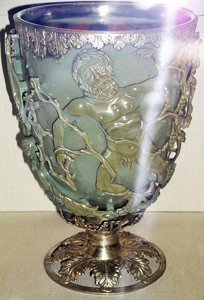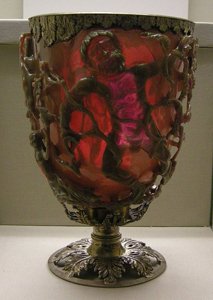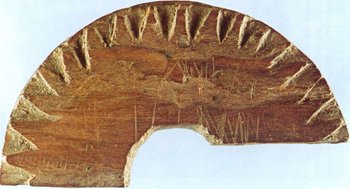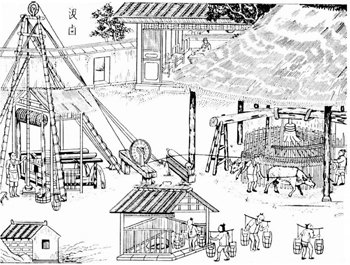Modern humans are the best humans. Just look back at those primitive troglodytes from hundreds of years ago: what a bunch of idiots. Probably don't even know how to work an iPhone. Truly, we are superior in every way, save for beard-growing abilities. Or are we? Historians are digging up evidence that indicates some ancient humans had their shit together in ways modern humanity can still barely manage. Just look at ...
5. The Magical Roman Technicolor Cup
The Lycurgus Cup is an Ancient Roman goblet kicking around at the Smithsonian. You might wonder what could possibly be so technologically advanced about a cup (does it shimmy over to the fridge and fill itself with beer?). Scientists didn't notice anything special about it either, until they held it up to the light. You see, it looks green when lit from the front:

But when lit from behind, it turns a demonic red:

In 1990, British researchers tried to unlock the mystery of the devil's beer stein. What they found was that the glass was full of gold and silver flecks 1,000 times thinner than a human hair. Basically, the Romans discovered nanotechnology -- the science of manipulating incredibly small particles -- and used it to make a bitchin' pimp cup.

To make the cup, they would have had to grind up gold and silver into grains many times smaller than sand and fuse it to the glass in specific proportions to produce subatomic effects that we're only just beginning to understand in recent decades. For some reason, the scientists weren't allowed to take this millennia-old relic and fill it with Tang and tequila (That's a TnT, and we heartily recommend it) just to see what happened. So they did their best to replicate it and found that it would probably also have changed colors based on what kind of liquid was poured into it. It's a Hypercolor chalice! What's more, it's even more effective at detecting different kinds of substances in water than modern sensors are, which means that science is actually considering using a piece of technology from the time of Caesar to improve modern substance detectors. The Ancient Romans were so good at getting drunk that they broke the science of the future.
4. Viking Compasses Nearly as Good as GPS

Navigating the ocean back in ancient times was extremely tricky, given that they didn't have GPS, compasses, or even shuffleboard on those rickety old cruise ships. If you wanted to go from, say, Europe to the Americas back then, you were just as likely to crash into Madagascar since all that water looks the same out there. Scientists were puzzled about how the Vikings were consistently able to travel in a totally straight line from Norway to Greenland and back, some 1,600 miles, while the rest of the world was rowing around in circles, too proud to ask the passing mermaids for directions. Then, in 1948, they found an ancient Viking artifact under an 11th-century convent and concluded it was a shockingly advanced compass.

Before magnetic compasses, ancient mariners had to find their way using sundials, which told time and direction by shining a shadow onto a disc. As you can imagine, at night or even on a cloudy day, they were about as useful as reading tea leaves and sacrificing a goat to Odin. But the Viking compass, known as the Uunartoq disc, had ways of getting around that. On top of being an amazingly sophisticated sundial with several shadow sticks to work out the cardinal directions, medieval records of the device refer to a "magic" crystal that enabled it to work even when the sun wasn't available. And while we're still jaded enough to put "magic" in sarcastic quotes, researchers believe that a certain kind of crystal placed in the device could have created a pattern on the disc when exposed to even dim light, which they could have used to find their way.

Upon testing, scientists found less than 4 degrees of error, which is comparable to modern compasses. Even with these results, we still don't know everything about the compass or if it was even more accurate, since half of it was missing when we uncovered it. In any case, we can confidently state the ancient Vikings at least had Apple Maps beat.
3. Massive Drills and Natural Gas Pipelines in Ancient China

Salt was a highly valuable resource in the ancient world, both as a preservative before refrigeration and as the only weapon keeping the slug people away. But when you live in a country as big as China, you can't necessarily make a trip out to the beach to collect some seawater. Because Safeway wouldn't be invented for another couple of thousand years, the Chinese had no choice but to dig down into the ground in search of that savory white gold.
And we don't mean they were really good with shovels. The Chinese invented a huge drill consisting of a length of bamboo with an iron bit at the end, which several men would use to excavate deep wells into the Earth. They may have looked comically unsafe, but by the 3rd century their salt wells reached as far down as 460 feet into the ground.

Their drilling methods weren't just ingenious, they were also sophisticated. They designed a whole catalog of drill tips for different circumstances, and even had a protocol for repairing cave-ins underground from the safety of the surface.

These bore-holes also released methane pockets, and so were dubbed "fire wells." But an initially explosive problem became an asset as the Chinese realized they could use this natural gas to power their prehistoric appliances. They transported the gas through a far-reaching series of bamboo pipelines which would carry both the saltwater and the gas great distances, including under roads. Sure, we have natural gas pipelines in the modern world too. But we don't have a tap that pours hot and cold running salt. Point: Ancient China.
3. Ancient Metal Plating (That's Still Better Than Ours)

We know that people of the middle ages and earlier had the ability to coat materials with thin films of metal like gold and silver. In fact, their methods functioned even better than the ones we use today. We still haven't caught up to the middle ages. But it gets better: the Iron Pillar is a column in the Qutb Complex of Delhi. It was built around A.D. 400 and enjoys thoroughly mocking archaeologists and metallurgists, because it's 1,600 years old and it has not corroded yet. Compare that to your 1994 Ford Festiva and you might start to see what an accomplishment that truly is.

Studies of the Iron Pillar show that its composition is unusually high in phosphorous, which seems to have shielded the metal underneath from the ravages of nature. It basically nurtures a thin film of harmless rust that gets metallic Stockholm Syndrome and fights off deeper, more damaging rust. That's not an accident: earlier iron works are lacking that phosphorous, while several later structures were forged in the same fashion. That's right: ancient Indians bought the undercoating, and it's still paying off millennia later.
1. The Ancient Greeks Built Programmable Robots

If you're looking for evidence that time travel exists, you really can't do better than Heron of Alexandria ("Hero," if you're nasty). We've mentioned before that he was responsible for the first steam engine, as well as automatic doors, and even a robot show back in the first century -- but those weren't even his most impressive feats. Researchers now credit him for the first goddamn programmable robot.

It might seem silly to call what Hero (we're apparently nasty) built a "robot," considering it was a wooden three-wheeled cart powered by string instead of electricity. But using a system of timed weights and pulleys, the thing could move by itself, turn corners, and hopefully sass nearby humans. Despite its crudeness, computer scientists say that this is basically the way that all robots operate. It's just Hero's "strings of code" were literal strings. They even built one to show that it works and wasn't just the product of Hero's fevered imagination:
Hero didn't actually do much with it besides entertain the masses and hopefully get a little strange now and then. At least, as far as we know. Maybe we're all stuck in some kind of Ancient Greek Matrix right now, and the world we think we know is just an elaborate knitting project designed to keep us docile.

Hi! I am a robot. I just upvoted you! I found similar content that readers might be interested in:
http://www.cracked.com/article_21686_5-awesome-technologies-created-by-ancient-civilizations.html
Downvoting a post can decrease pending rewards and make it less visible. Common reasons:
Submit
Awesome
Downvoting a post can decrease pending rewards and make it less visible. Common reasons:
Submit
A great article i am sure we are missing a big part of are real history or not being told the real truth
Downvoting a post can decrease pending rewards and make it less visible. Common reasons:
Submit
The truth is we have de-evolved
Downvoting a post can decrease pending rewards and make it less visible. Common reasons:
Submit